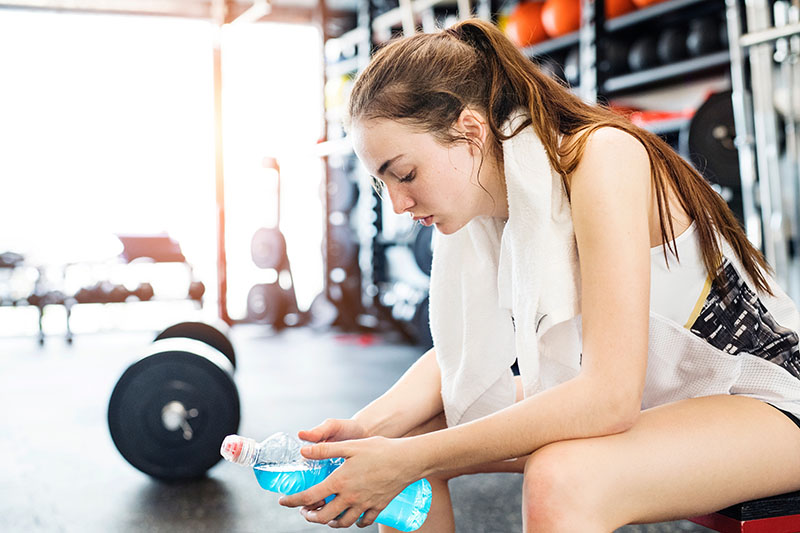
When the weather starts to get nicer and the temperature rises, people tend to engage in more outdoor activities. That can be pleasant, but it can also have a downside if we’re not careful. Exercising in warmer weather increases the amount of body fluid we lose through sweating, and that means we need to take steps to ensure our bodies get enough fluids to keep us well hydrated.
Water makes up a large percentage of our bodies. In fact, 60% of our total body weight is water and 75% of our muscles are made up of water. In addition, bodies need fluids for many essential functions, including:
- Controlling body temperature
- Keeping blood pressure at a healthy level
- Lowering the risk of dehydration and heat stroke
- Moving nutrients and waste through the body
- Cushioning and protecting organs and joints
When we lose more fluids than we take in, our body can become dehydrated, and that can cause minor to severe consequences:
- Breakdown of skeletal muscle
- Confusion
- Dry nasal passages
- Dry or cracked lips
- Dark-colored urine
- Fatigue
- Hallucinations
- Headaches
- Heat exhaustion and heat stroke
- Mood changes
- Muscle cramps
- Slow reaction times
- Weakness
If we become dehydrated and don’t replace the fluid we’ve lost, it is likely to affect our physical and mental performance.
Preventing Dehydration
So how do we prevent dehydration? Simple, we drink more fluids. But how much should we drink? That depends. Everyone is different, but there are some signs we can watch for that point to the possibility of dehydration. Although thirst is a symptom of dehydration, we should not wait until we are thirsty before getting something to drink. By the time that happens, we’re likely already experiencing the beginning stages of dehydration.
Other signs of dehydration include:
- Chills
- Clammy skin
- Dizziness
- Dry mouth
- Elevated heart rate
- Headache
- Nausea
- Shortness of breath
Drinking smaller amounts of liquids throughout the day is better than drinking large quantities a couple of times a day. Choose water most often; it is natural, contains no calories, and is readily available. Try to avoid soft drinks, and limit beverages with caffeine to a maximum of three cups a day.
Drinking to prevent dehydration is always important, but it is particularly important when we are being physically active, especially in warm weather. A general recommendation is to drink as much liquid as you can comfortably manage before exercising, while you are being physically active, and after you are through finished exercising. The chart below outlines a common guideline for fluid intake that can be adjusted based on your activity level.
| How much liquid to drink | When to drink it |
| 2 -3 cups | About 2 hours before exercising |
| 1 cup | 5 to 10 minutes before exercising |
| 1 cup | Every 15 to 20 minutes during exercise |
Here are some other tips that can help you avoid becoming dehydrated.
- Drink plenty of water every day, not just when you plan to be physically active.
- Make sure you will have access to water while you are exercising. You may have to bring your water with you.
- Avoid drinking alcohol, which can increase dehydration.
- Do not take salt tablets.
- Stop exercising if you become light-headed or dizzy.
- When the temperature is very hot or the air is very dry, exercise early in the day or later in the evening, when it is cooler.
- Consider beverages that include electrolytes if your exercise is vigorous.
Electrolytes
Electrolytes are minerals with an electrical charge. Our bodies require small electric currents, which electrolytes provide, to conduct many body functions. Some people can maintain a healthy electrolyte balance through a nutritious diet. Others, including high-performance athletes and people who are ill and dehydrated, may need more.
Among the minerals classified as electrolytes are calcium, chloride, magnesium, phosphate, potassium, and sodium. Some beverages are natural sources of electrolytes, and others have electrolytes added to them when they are processed.
Sports drinks are common electrolyte beverages. They are a convenient way for high-endurance athletes to stay hydrated and replace the electrolytes they lose through sweating. But they tend to contain more electrolytes than an average person needs.
Another type of commercially available electrolyte drink is known as an oral electrolyte solution, or oral rehydration salts. These drinks are typically formulated with the right balance of electrolytes and sugar to help people recover from dehydration. They are available in convenient premeasured sachets or effervescent tablets to add to water, or ready to drink formulations.
Your healthcare team can help you create a plan to exercise safely and avoid becoming dehydrated. Exercise can improve your health, and preventing dehydration is an important part of that. Your London Drugs pharmacists can advise you of the different types of electrolyte replacement products available to help you stay well hydrated.






